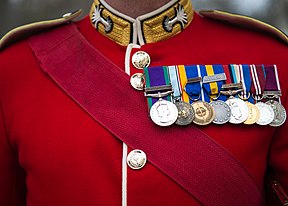
Back ريد كوت Arabic ريد كوت ARZ রেড কোট (ব্রিটিশ সেনাবাহিনী) Bengali/Bangla Rotrock German Jaka gorriak Basque کتقرمز (لباس همسان نظامی) Persian Punatakki Finnish Tuniques rouges French Casacas vermellas Galician המעילים האדומים HE
Red coat, also referred to as redcoat or scarlet tunic, is a military garment formerly much used by most regiments of the British Army, so customarily that the term became a common synecdoche for the soldiers themselves.
The red coat was widely (though not exclusively) used by the infantry and some cavalry units of the British military plus the Royal Marines, from the 16th to the early 20th centuries. The garment was also widely used by the British Colonial Auxiliary Forces and the British Indian Army during the same period. Though, by the 20th century, the red coat was abandoned for practical duties in favour of khaki by all British Empire military units, it continues to be used for ceremonial full dress and mess dress uniforms in many countries of the Commonwealth of Nations.[1]
The usage of red coats by English soldiers dates back to the Tudor period, when the Yeomen of the Guard and the Yeomen Warders were both equipped in the royal colours of the House of Tudor, red and gold. During the Tudor conquest of Ireland and the Wars of the Three Kingdoms, units of English soldiers were equipped in red coats, most notably the New Model Army, which fought on the Parliamentary side.[2][3][4]
From the mid-17th century to the 19th century, the uniform of most British soldiers (apart from artillery, rifles and light cavalry) included a madder red coat or coatee. From 1873 onwards, the more vivid shade of scarlet was adopted for all ranks, having previously been worn only by officers, sergeants and all ranks of some cavalry regiments.[5]
- ^ Concise Oxford Dictionary 1982, p. 868, ISBN 0-19-861131-5
- ^ Abbé MacGeoghegan, History of Ireland, Ancient and Modern (Paris, 1758), trans. P. O'Kelly (1832), Vol. III, p.109.
- ^ Historiae Catholicae Iberniae Compendium by Philip O'Sullivan Beare (1621), Tome II, Bk IV, Chap III, translated as Ireland Under Elizabeth by Matthew J. Byrne (1903). See p. 5 of Byrne's translation.
- ^ 'Elizabeth I: volume 180, June 1595', in Calendar of State Papers, Ireland, 1592-1596, ed. Hans Claude Hamilton (London, 1890), p. 322.
- ^ Major R.M. Barnes, A History of the Regiments & Uniforms of the British Army. Sphere Books Ltd, London (1972), p.257

